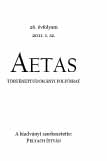A Magyaros tető elfoglalása 1917. március 8-án
The capture of Magyaros-tető on 8 March 1917
Author(s): Tamás CsikánySubject(s): History
Published by: AETAS Könyv- és Lapkiadó Egyesület
Summary/Abstract: The First World War is depicted in history books as one in which life was worth almost nothing, and military leaders of all ranks, regardless of which country's or coalition's army they were commanding, cared about nothing else but the goal to be achieved. Yet big victories did not materialize and not even the smaller ones were made use of. Rather the war was decided by economic factors, by the richness of available human and financial resources. Reality, however, is not this one-dimensional. Those commanders who felt responsibility for their soldiers did their best to spare their lives, especially as it became more and more difficult to replace them. This was all the more so in the armies of the Central Powers. They were the firsts to make attempts to develop such military solutions with which the goals (breaking through the enemy defense, eliminating it and capturing enemy positions) could be achieved with minimal losses. Yet, in the age of machine guns, precise and quick-firing artillery such efforts could rarely have been successful. The German army used the so called shock troops first in the Western Front. These smaller, well-equipped units were deployed unexpectedly, at selected locations and directions after short but sharp artillery preparation fire. If they managed to infiltrate enemy defense lines the attack continued in the traditional manner. The 39th infantry division of the Hungarian army was still able to achieve a very spectacular and important success. At the end of 1916, the division was chasing the Romanian troops, which had infiltrated the country, through Csík county in the valley of the stream Úz and reached the Eastern borders of Hungary. As the Romanian army had already prepared and established positions during peacetime along the banks of the stream, the Hungarian division needed to halt there. In the middle of November, the Romanian forces were replaced by Russian troops in significantly superior numbers, and they almost immediately went on the attack along the entire line. As a result, in December they captured the peaks of Lápos, Magyaros and Söverjes, the possession of which could have meant great advantages for the entire front line. The German divisions refused to attempt to recapture the peaks, but the chosen troops of the 39th infantry division of the Hungarian army launched a surprise “shock attack” on 8 March 1917, and recaptured the peaks with only slight losses. The attack was led by major general József Breit, who later as a military historian wrote a book on the military history of Hungary. The paper describes the circumstances of this attack, and its thorough and careful preparation as well as the attack itself.
Journal: AETAS - Történettudományi folyóirat
- Issue Year: 2011
- Issue No: 1
- Page Range: 5-24
- Page Count: 20
- Language: Hungarian

